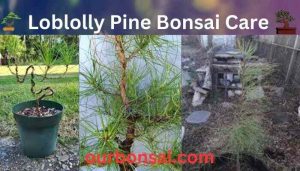Loblolly Pine Bonsai Care – Find out how to care for your Loblolly Pine bonsai to keep it vibrant and healthy. Get top tips on watering, sunlight, and fertilization!
Table of Contents
ToggleLoblolly Pine Bonsai requires full sun, well-draining soil, and regular watering. Prune and wire regularly to shape the tree.
Loblolly Pine Bonsai is a captivating miniature tree. It thrives in full sun and requires specific care to flourish. Proper watering, pruning, and wiring are essential for maintaining its shape and health. Well-draining soil is crucial to prevent root rot.
Regularly check for pests to ensure a healthy bonsai. This type of bonsai adds a unique, natural beauty to any space. With dedicated care, a Loblolly Pine Bonsai can become a stunning, long-lasting addition to your collection. Always monitor its growth and adjust care routines as needed. This ensures the tree remains vibrant and beautiful for years.
Loblolly Pine Bonsai Care
Caring for a Loblolly Pine Bonsai involves regular pruning and ensuring proper sunlight exposure. Water deeply, allowing the soil to dry slightly between waterings.
Caring for a Loblolly Pine Bonsai involves a mix of art and science. This tree offers a rewarding experience for bonsai enthusiasts, thanks to its unique characteristics and resilience. Let’s dive into the essentials of Loblolly Pine Bonsai care.
Watering
Proper hydration is crucial for the health of your Loblolly Pine Bonsai. Here are some key points to consider:
- Consistent moisture: Keep the soil consistently moist but not waterlogged.
- Watering frequency: Water the bonsai daily during summer and reduce frequency in winter.
- Drainage: Ensure the pot has good drainage to prevent root rot.
Loblolly Pine Bonsai Care, Light Requirements
Loblolly Pine Bonsai thrives with adequate light. Understanding its light needs will help it flourish.
This tree prefers full sunlight. Place it in a spot where it can receive at least six hours of direct sunlight each day. If grown indoors, consider using grow lights to supplement natural light.
Soil And Fertilization
The right soil mix and fertilization routine can make a significant difference. Here are the essentials:
- Soil mix: Use a well-draining bonsai soil mix that retains some moisture.
- Fertilization schedule: Feed the bonsai with a balanced fertilizer every two weeks during the growing season.
- Winter feeding: Reduce fertilization in winter to once a month.
Pruning And Wiring
Maintaining the shape and health of your Loblolly Pine Bonsai requires regular pruning and wiring.
- Pruning: Trim new growth regularly to maintain the desired shape and encourage branching.
- Wiring: Wire the branches during the growing season to shape the tree. Be gentle to avoid damaging the bark.

Loblolly Pine Bonsai Care Pests And Diseases
Keeping your bonsai free from pests and diseases is vital for its health.
- Common pests: Watch out for aphids, spider mites, and scale insects.
- Disease prevention: Ensure proper air circulation and avoid overwatering to prevent fungal infections.
- Treatment: Use organic insecticides and fungicides as needed.
Repotting
Regular repotting helps maintain the health of your bonsai. Here’s what you need to know:
- Repotting frequency: Repot every 2-3 years during early spring.
- Root pruning: Trim one-third of the roots during repotting to encourage new growth.
- New soil: Refresh with new bonsai soil mix to provide fresh nutrients.
By following these guidelines, your Loblolly Pine Bonsai will thrive and become a beautiful, miniature representation of its natural form. Enjoy the journey of nurturing this remarkable tree.
Loblolly Pine Bonsai Care Watering
Loblolly Pine Bonsai requires consistent watering to thrive. Maintain soil moisture without overwatering to prevent root rot. Ensure proper drainage to keep the bonsai healthy.
Caring for a Loblolly Pine Bonsai involves understanding its specific watering needs. Proper hydration is crucial for the plant’s health and growth. This section will guide you through essential tips for watering your Loblolly Pine Bonsai effectively.
Determining Water Needs
Loblolly Pine Bonsai trees have distinct water requirements. Here are key factors to consider:
- Soil moisture: Check the soil regularly to ensure it’s moist but not waterlogged.
- Seasonal changes: Water needs vary with seasons. Increase watering in summer and reduce in winter.
- Tree size: Larger trees may need more water due to their extensive root systems.
Watering Frequency
The frequency of watering your Loblolly Pine Bonsai is essential for its health.
Water the tree when the top inch of soil feels dry. During hot months, it may need daily watering. In cooler seasons, reduce the frequency to avoid root rot. Always adjust based on soil and climate conditions.
Best Time To Water
Choosing the right time of day to water your bonsai can make a difference.
- Early morning: Best time as the water can soak in before the heat of the day.
- Late afternoon: Watering at this time helps the tree retain moisture overnight.
- Avoid midday: Watering during the hottest part of the day can lead to rapid evaporation.
Watering Techniques
Proper techniques ensure your bonsai gets the water it needs without wasting resources.
- Deep watering: Water deeply to reach the roots, ensuring thorough hydration.
- Use a watering can: A can with a fine nozzle helps distribute water evenly.
- Avoid splashing: Direct water to the soil, not the foliage, to prevent fungal issues.
Signs Of Overwatering And Underwatering
Recognizing signs of overwatering or underwatering can prevent damage to your bonsai.
- Yellowing leaves: Indication of overwatering, leading to root rot.
- Wilting leaves: Sign of underwatering and dehydration.
- Mold growth: Overwatering can cause mold on the soil surface.
By following these tips, you’ll maintain a healthy and vibrant Loblolly Pine Bonsai. Proper watering is key to its growth and longevity.
Loblolly Pine Bonsai Care Watering Indoors
Loblolly Pine Bonsai requires consistent watering to thrive indoors. Ensure the soil remains slightly moist but never waterlogged. Regularly check soil moisture levels to maintain optimal health.
Caring for a Loblolly Pine bonsai indoors requires attention to detail, especially with watering. These majestic trees thrive when their specific needs are met, making them a rewarding addition to your indoor garden.

Understanding Watering Needs
Proper hydration is crucial for a healthy Loblolly Pine bonsai. These trees prefer consistently moist soil but dislike being waterlogged. This delicate balance is key to their well-being.
Best Watering Practices
To ensure your bonsai thrives, follow these guidelines:
- Check soil moisture: Insert your finger about an inch into the soil to feel the moisture level.
- Water thoroughly: Ensure the entire root system receives water, but avoid letting the pot sit in water.
- Use room temperature water: Cold water can shock the roots, while warm water is more readily absorbed.
- Adjust with seasons: Indoor environments change with seasons, so monitor and adjust watering frequency accordingly.
Preventing Overwatering
Overwatering can be detrimental to your bonsai. Here are some tips to avoid it:
- Ensure good drainage: Use a well-draining soil mix and a pot with drainage holes.
- Avoid frequent shallow watering: This can lead to root rot. Always water deeply and less frequently.
- Observe the tree: Yellowing needles can be a sign of overwatering, prompting you to reduce water amounts.
Signs Of Underwatering
Underwatering is equally harmful. Look out for these indicators:
- Dry, brittle needles: This is a clear sign that your bonsai needs more water.
- Wilting branches: Indicate a lack of sufficient hydration.
- Soil pulling away from the pot edges: This shows the soil is too dry and needs immediate attention.
Establishing A Routine | Loblolly Pine Bonsai Care
Creating a consistent watering schedule helps maintain your bonsai’s health. Here are some tips:
- Set reminders: Use a calendar or an app to remind you of watering days.
- Observe and adjust: Each bonsai is unique, so adjust your routine based on your tree’s specific needs.
- Keep a journal: Note any changes in the tree’s appearance and adjust watering habits as necessary.
By following these guidelines, your Loblolly Pine bonsai will flourish indoors, adding a touch of nature to your living space.
Loblolly Pine Bonsai Care Outdoor Watering
Loblolly Pine Bonsai thrives with consistent outdoor watering. Ensure the soil remains moist but not waterlogged. Regularly check for drainage to prevent root rot.
Caring for a Loblolly Pine bonsai involves specific techniques, especially concerning outdoor watering. This guide will help you ensure your bonsai thrives.
Importance Of Proper Watering
Watering your Loblolly Pine bonsai correctly is crucial. It ensures the tree’s health and vitality.
Frequency Of Watering
Consider the following points regarding how often you should water your bonsai:
- Daily Check: Examine the soil daily to ensure it isn’t drying out.
- Seasonal Changes: Adjust watering frequency based on the season. More in summer, less in winter.
- Soil Moisture: Water when the top inch of soil feels dry.
Amount Of Water
Applying the right amount of water keeps your bonsai healthy.
- Soak Thoroughly: Ensure water reaches the roots by soaking the soil completely.
- Avoid Overwatering: Prevent root rot by letting excess water drain away.
- Use a Watering Can: A gentle flow avoids disturbing the soil.
Ideal Time To Water
Choosing the best time of day for watering affects the bonsai’s absorption.
- Morning Routine: Watering in the morning is ideal. It gives the tree time to absorb moisture.
- Avoid Evening: Watering at night can lead to excessive moisture and fungal issues.
Signs Of Under Or Over Watering
Recognizing these signs can help you adjust your watering habits.
- Yellowing Leaves: Overwatering might cause leaves to turn yellow.
- Dry, Brittle Leaves: Underwatering results in dry, brittle foliage.
- Root Health: Check roots periodically. Healthy roots indicate proper watering practices.
Proper outdoor watering can make a significant difference in the health of your Loblolly Pine bonsai. Follow these guidelines to keep your bonsai flourishing.
Loblolly Pine Bonsai Care Indoors
Loblolly Pine Bonsai care indoors involves ensuring ample sunlight, regular watering, and maintaining proper humidity. Use well-draining soil and prune regularly to shape and maintain health.
Caring for a Loblolly Pine Bonsai indoors can be a rewarding experience. With proper attention and care, you can maintain a healthy and aesthetically pleasing bonsai tree. Let’s explore the essential aspects of indoor care for your Loblolly Pine Bonsai.

Light Requirements
Providing adequate light is crucial for your bonsai’s health. Here’s how to ensure it gets enough light:
- Bright, Indirect Light: Place your bonsai in a spot where it receives bright, indirect sunlight for at least six hours daily.
- Artificial Lighting: Use grow lights if natural light is insufficient. Position the light 6-12 inches above the tree.
- Rotate Regularly: Turn the bonsai every few days. This helps in even light distribution and balanced growth.
Watering Schedule
Watering your bonsai correctly is vital. Let’s break down the watering needs:
- Check Soil Moisture: Insert your finger into the soil about an inch deep. Water if it feels dry.
- Water Thoroughly: Ensure water reaches all parts of the soil. Allow excess water to drain out.
- Humidity: Maintain higher humidity levels. Use a humidity tray or mist the leaves regularly.
Temperature And Humidity
Creating the right environment is key to your bonsai’s well-being. Here’s what you need to do:
Loblolly Pine Bonsai prefers moderate temperatures and humidity levels. Keep the temperature between 60-75°F. Avoid placing it near drafts or heating vents. Maintain indoor humidity around 50-60% using a humidifier or a water tray.
Fertilizing
Feeding your bonsai ensures it gets the nutrients it needs. Here are the fertilizing guidelines:
- Balanced Fertilizer: Use a balanced, slow-release fertilizer once a month during the growing season.
- Diluted Fertilizer: Apply a diluted liquid fertilizer bi-weekly during the growing season.
- Winter Rest: Do not fertilize during the winter dormancy period.
Loblolly Pine Bonsai Care, Pruning And Wiring
Maintaining the shape and health of your bonsai involves regular pruning and wiring. Here’s how:
Regular pruning helps in maintaining the desired shape and size. Trim new growth back to a few pairs of needles. Use wire to shape branches, but be careful not to damage the bark. Check wires regularly and remove them before they cut into the bark.
Repotting
Repotting your Loblolly Pine Bonsai is necessary for its growth. Here’s a quick guide:
- Frequency: Repot every 2-3 years. This prevents root binding and refreshes the soil.
- Timing: Best done in early spring before new growth starts.
- Procedure: Trim one-third of the roots and use well-draining bonsai soil. Ensure the new pot has proper drainage holes.
By following these indoor care tips, you can ensure your Loblolly Pine Bonsai thrives and remains healthy.
Loblolly Pine Bonsai Care Outdoor
Caring for Loblolly Pine bonsai outdoors involves providing ample sunlight and well-drained soil. Regular watering and pruning help maintain its shape and health. Protect the tree from harsh winter conditions.
Caring for a Loblolly Pine bonsai outdoors can be a deeply rewarding experience. These majestic trees can thrive when given the right conditions and attention. Here’s how to ensure your Loblolly Pine bonsai flourishes in an outdoor setting.
Sunlight Requirements
Loblolly Pine bonsai trees need plenty of sunlight to grow healthily. Here are the key points:
- Full sun: Place your bonsai in a location where it receives at least 6 hours of direct sunlight daily.
- Morning sun: Morning sunlight is beneficial as it’s less intense and helps the tree start its day.
- Seasonal adjustment: Move the tree to ensure it gets enough light during different seasons.
Watering Schedule
Proper watering is crucial for the health of your bonsai. It’s essential to maintain a consistent watering schedule.
The tree prefers moist but not waterlogged soil. Water thoroughly until it drains from the bottom. During hot weather, check soil moisture frequently. In cooler months, reduce watering frequency.
Soil And Fertilization
Loblolly Pine bonsai trees require specific soil and regular fertilization. Here’s a brief guide:
- Well-draining soil: Use a bonsai mix with good drainage to prevent root rot.
- Fertilize regularly: Apply a balanced fertilizer every two weeks during the growing season.
- Organic fertilizer: Consider using organic options to promote healthy growth.
Pruning And Wiring
Maintaining the shape of your bonsai involves regular pruning and wiring. Here are some tips:
- Prune for shape: Trim new growth to maintain the desired shape of the tree.
- Wire branches: Use bonsai wire to train branches, but avoid wrapping too tightly.
- Monitor growth: Regularly check and adjust wiring to prevent damage.

Pest And Disease Control
Keeping your bonsai free from pests and diseases is vital for its health. Here are steps to take:
- Inspect regularly: Check for signs of pests like aphids and spider mites.
- Natural remedies: Use neem oil or insecticidal soap to treat infestations.
- Disease prevention: Ensure proper airflow and avoid overwatering to prevent fungal diseases.
Winter Care
Winter care is crucial for the survival of your Loblolly Pine bonsai. Follow these guidelines:
- Protect from frost: Move the tree to a sheltered location to avoid frost damage.
- Reduce watering: Water less frequently but ensure the soil doesn’t dry out completely.
- Mulch application: Apply mulch around the base to insulate roots and maintain moisture.
By following these guidelines, your Loblolly Pine bonsai can thrive in an outdoor environment, bringing natural beauty and tranquility to your space.
Where Do Loblolly Pines Grow Best?
Loblolly Pines thrive in well-drained, acidic soil with full sunlight. Ideal regions include the Southeastern United States. Proper watering and pruning enhance the health of Loblolly Pine bonsai.
The Loblolly Pine, known for its adaptability and resilience, makes a stunning bonsai specimen. Understanding where these trees thrive is crucial for successful bonsai care.
Native Range
Loblolly Pines naturally grow in the southeastern United States. They are commonly found in:
- Coastal Plains: These areas provide the sandy, well-drained soils Loblolly Pines love.
- Piedmont Region: This area offers a mix of soil types, ideal for Loblolly Pine growth.
- Lower Mississippi Valley: The climate here supports the Loblolly Pine’s need for warmth and humidity.
Optimal Climate
These trees thrive in specific climates. Let’s explore the key climate factors:
- Warm Temperatures: Loblolly Pines prefer temperatures between 60-80°F.
- High Humidity: These pines need humidity levels around 70-80%.
- Ample Rainfall: Ideal annual rainfall ranges from 40-60 inches.
Soil Preferences
Loblolly Pines are particular about their soil. They flourish best in certain soil types:
- Sandy Soils: Excellent drainage and aeration for roots.
- Acidic pH: Soil pH between 5.5 and 6.5 is perfect.
- Nutrient-Rich: Essential for robust growth and health.
Loblolly Pine Bonsai Care, video!
Sunlight Requirements
Proper sunlight is crucial for healthy Loblolly Pine bonsai. These trees need:
- Full Sun: At least 6 hours of direct sunlight daily.
- Partial Shade: Beneficial during the hottest part of the day.
- Balanced Light: Ensures even growth and strong foliage.
Geographic Adaptability
Loblolly Pines can adapt to various regions beyond their native range. They can grow in:
- Urban Areas: With proper care, they can thrive in city environments.
- Suburban Yards: Ideal for homeowners looking to cultivate bonsai.
- Rural Landscapes: Perfect for those with more space and natural conditions.

Frequently Asked Questions
How Do You Care For A Loblolly Pine Bonsai?
Loblolly Pine Bonsai requires well-draining soil and full sun. Water regularly but avoid overwatering. Prune in late winter to maintain shape.
What Is The Ideal Soil For Loblolly Pine Bonsai?
Use well-draining soil with a mix of akadama, pumice, and lava rock. This helps prevent root rot and promotes healthy growth.
How Often Should I Water My Loblolly Pine Bonsai?
Water your Loblolly Pine Bonsai when the top inch of soil is dry. Avoid waterlogging the roots to prevent root rot.
Can Loblolly Pine Bonsai Grow Indoors?
Loblolly Pine Bonsai prefers outdoor conditions. It needs full sun and good air circulation for optimal growth. Indoor conditions are not ideal.
Conclusion
Caring for a Loblolly Pine Bonsai requires attention to detail and patience. With proper care, it will thrive beautifully. Focus on watering, pruning, and providing the right environment.
This effort will reward you with a stunning bonsai. Enjoy the process and watch your Loblolly Pine flourish.
Happy gardening!
